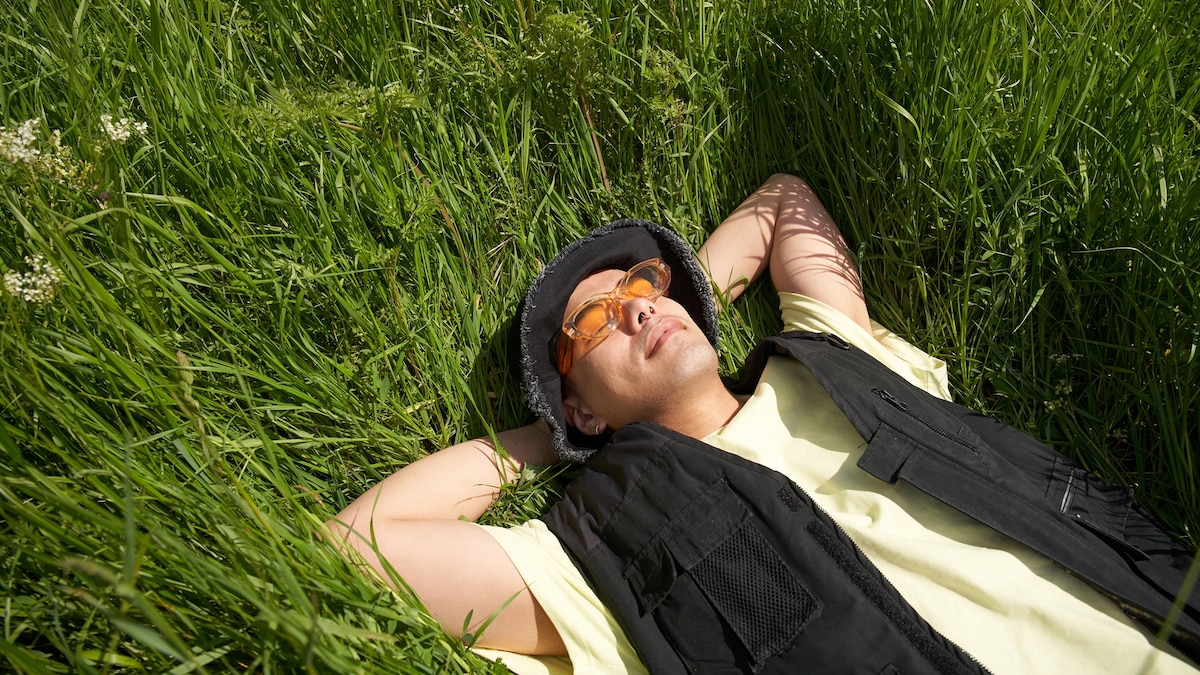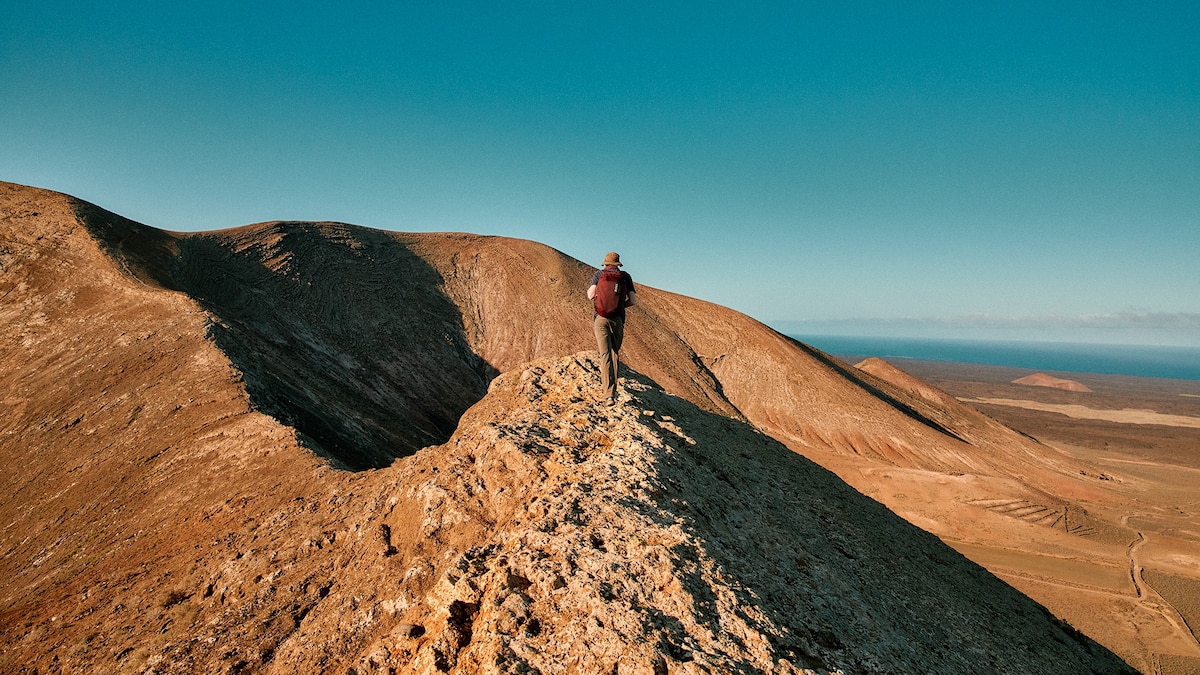Now Reading: Nat Geo’s ultimate guide to ‘touching grass’
-
01
Nat Geo’s ultimate guide to ‘touching grass’
Nat Geo’s ultimate guide to ‘touching grass’

If you’re in the mood for a reality check, take a look at how much time you’ve spent staring at your phone this week. We’ll wait…
Are you shocked? Slightly ashamed? Or perhaps inspired to spend less time brain rotting your way into the void?
Well, experts have one piece of advice for you: Touch grass.
Yes, literally. But also metaphorically: To “touch grass” is to disconnect from the virtual world and reconnect with the physical one. You know, breathe fresh air, sit under a tree, that kind of thing, says Holli-Anne Passmore, an associate professor of psychology at Concordia University of Edmonton in Canada and director of the international Nature-Meaning in Life research lab.
The phrase has gained momentum on social media as a sort of wake-up call for the chronically online to put their devices down and spend time outdoors. And for good reason—decades of research shows that nature truly is medicine, so much so that some doctors even prescribe it!
(Here’s what happens to your brain when you take a break from social media.)
“Whether we realize it or not, we are inherently drawn to nature,” Passmore says, “yet we tend to grossly underestimate how much better it actually makes us feel.”
Exposure to green space has been found to lower blood pressure and cholesterol, as well as rates of diabetes, asthma, heart disease, stroke, and overall death. Experiments have also shown that time in nature improves memory, attention, and mood, and encourages empathy and cooperation. There’s even evidence that trees release chemicals that can boost our immune systems once inhaled—which you might have experienced if you’ve ever tried “forest bathing.”

Does the greenery cascading off this luxury hotel in Singapore look soothing to you? Even in an urban environment, a touch of green space has been shown to lower blood pressure and cholesterol, as well as rates of diabetes, asthma, heart disease, stroke, and overall death.
Photograph by Lucas Foglia, Nat Geo Image Collection
We might be biased, but National Geographic is quite the expert in touching grass. So if you’re ready to reset and maybe even get your hands dirty, here’s the ultimate guide on how to get started.
Bring the outdoors in
It can be intimidating to spend time outside if you’re a longtime homebody or allergic to everything. But there’s no shame in taking it slow. First order of business? Bring nature inside.
As Stacey Colino reported in our 2023 story on why nature is good medicine, even just looking at a potted plant on your desk or a photograph of ocean waves offers similar benefits as observing the real thing outside. Research has found that looking at natural fractals—repetitive patterns in flowers, ferns, mountains, and other nature scenes—produces more brain activity that’s associated with a relaxed yet wakeful state. Talk about a productive work-from-home day.
You can also keep fragrant flowers on your nightstand or an aroma diffuser with essential oils like lavender or rosemary; watch a nature documentary; or use an app to bring bird, rain, or ocean sounds into your home.
(What happens to your brain when you see a bird in nature?)
“It’s about your relationship with the natural world,” Passmore says. “It’s not just about getting outside.”
Look up at the night sky
You don’t need to live by the beach or mountains to connect with nature—all you have to do is look up.
Gazing up at daytime clouds will definitely do the trick. But mounting evidence shows that the dark sky can fill us with even more awe, or as Julia Flynn Siler wrote, “a sense of wonder as we contemplate the vastness of the cosmos.” This emotion, according to science, can lower inflammatory responses in the body, calm our nervous system, and spur the release of the “love” hormone oxytocin.
Not to mention, darkness plays a critical role in keeping our biological clock, or circadian rhythm, in check and encouraging our melatonin levels to rise, which prepares us for a good night’s rest.
(How to take great photographs at night.)
It’s really that simple! And there are plenty of upcoming celestial events to help you get started.
This month alone, you can catch Halley’s Comet’s glowing debris speed across the sky during the Eta Aquariid meteor shower. You can also witness Saturn’s equinox, an event that happens only once every 15 Earth years. In August, observe Venus and Jupiter’s close encounter, and in September, behold a blood moon as a total lunar eclipse unfolds.
Take your workout outside
Moving your body, no matter where you are, will provide myriad physical and mental health benefits. But you may want to consider doing it outdoors in what’s loosely referred to as “green exercise.”


Purple-pink rhododendron blooms line the cliff areas and forest floor in the New River Gorge National Park and Preserve in West Virginia. Hiking is one of our favorite ways to “touch grass” here at Nat Geo—especially on a trail in one of the 63 U.S. national parks.
Photograph by Jesse Thornton, Alamy Stock Photo (Top) (Left) and Photograph by Zachary Frank, Alamy Stock Photo (Bottom) (Right)
Research shows that workouts may feel easier and more enjoyable when done outside compared to inside; you may even find yourself exercising more when surrounded by trees compared to blank walls at the gym, according to one study.
You May Also Like
Then there are the workouts that are designed to be done outdoors. Hiking, for instance, is uniquely beneficial for the brain and body, as Daryl Austin reported last summer. Researcher shows that it can strengthen lung tissue and cardiac muscle, increase bone density, reduce anxiety, and improve problem-solving skills.
Need some inspiration? Consider trying one of our favorite hiking trails, including these hikes in the U.S. where you’ll find the wildflower-filled meadows of our dreams. Or opt for the more historical route with one of these ancient walking trails in the dense forests of northern Sweden and desert peaks of southern Jordan.
Rowing, pickleball, and cycling are other fun yet impactful activities that will have you touching grass in no time.
Protect wildlife in your own backyard
It can be quite the meditative experience to observe wild animals go about their days. In fact, studies show that watching and interacting with wildlife can enhance feelings of love, belonging, connection, and fulfillment. And the best part? You can do it anytime, anywhere—and help your fellow furry, feathery, or fishy friends along the way.
You can start a garden in a small container on your balcony and add native plants to help support pollinators. As Stuart Pimm, a conservation biologist at Duke University told us in 2023, “plant a few milkweed, and monarchs will be forever grateful.”

Firefly larvae glow from their home on a termite mound in Emas National Park, Goias, Brazil. Experts say there are easy steps you can take to ensure your own yard has the soil conditions that fireflies need to survive.
Photograph by EDSON VANDEIRA, Nat Geo Image Collection

A species of bioluminescent firefly, Photuris quadrifulgens, photographed in Holston River, Tennessee. Helping fireflies isn’t just good for their survival—it might just be the mental health boost you need from getting outside.
Photograph by DAVID LIITTSCHWAGER, Nat Geo Image Collection
Or perhaps you can use our tips to ensure your backyard is a safe haven for fireflies, which are dwindling across the globe thanks to habitat loss.
Another simple way to help wildlife (and yourself) thrive in the great outdoors: Attach a birdfeeder onto the outside of your window or hang one on a tree by your local bus stop. Doing so can be a boon for biodiversity.
Visit a national park
There are 63 national parks in the U.S. alone and thousands more worldwide, so you’re bound to find at least one that will make you wonder why you didn’t touch grass sooner.

A paddleboarder enjoys the serene, navigable waterways at Silver Springs State Park near Ocala, Florida. Research shows that workouts may feel easier and more enjoyable when done outside—and you may even find yourself exercising more when surrounded by trees compared to blank walls.
Photograph By Todd Anderson/The New York Times/Redux
Check out our list of the 10 most popular national U.S. parks where you can learn more about the towering waterfalls in California’s Yosemite National Park and the explosive geysers at Yellowstone National Park. We’ve also got exhaustive coverage of things to do in the parks on our National Parks hub.
Interested in visiting a park but can’t stand crowds? We’ve got a list for that too.
Get social IRL
Social media is a great way to connect with long-distance friends and family, but research shows that face-to-face contact can better boost mental health, fostering more trust and intimacy than you can achieve through a screen.
“A lot of people don’t have access to a community, but the truth is, in many cases you have to get out in the world and ‘touch grass’ if you want to have one,” says Sam Dalton, a licensed clinical social worker who frequently gives the same advice to her clients.
So maybe you should knock on your neighbor’s door for a cup of sugar like the good ol’ days, because as Anikka Hom reported in, asking for help is actually really good for you, and it gives others a sense of purpose.
In the meantime, we heard that social running is all the rage right now. Not only will the activity take you outdoors, but Hannah Singleton wrote in our July 2024 story that it can also help break social anxiety barriers with your community and build stronger bonds.

“Touching grass” doesn’t have to literally mean spending time outside. It can also mean spending time in the company of others—say, listening to this costumed mariachi band playing stringed instruments and trumpets at the Guadalajara Cathedral in Mexico.
Photograph by Alejandro Cegarra, National Geographic Image Collection
Go see the world
Sure, armchair travel is great and maybe all we have sometimes, but touching grass is, in the grand scheme of things, about exploring the world. And lucky for you, National Geographic assembled 25 best places in the world to travel to in 2025 to help plan your next big trip.
Only two hours from the famous (but overtouristed) Kyoto, you can visit the wooden teahouses, gardens, and samurai district in Kanazawa, Japan. Or take a cooking class or street food tour in Senegal in West Africa, where you can relish in the Wolof and French-influenced cuisine. In September, plan a visit to Cork, Ireland, and attend Sounds from a Safe Harbour, a festival of music, dance, and conversation.
One of the best parts about going out and touching grass, experts say, is that it helps you gain new perspectives about your place and role in the world in ways that staying indoors simply can’t.
“It makes you realize that you’re part of a greater whole,” Passmore says.

























